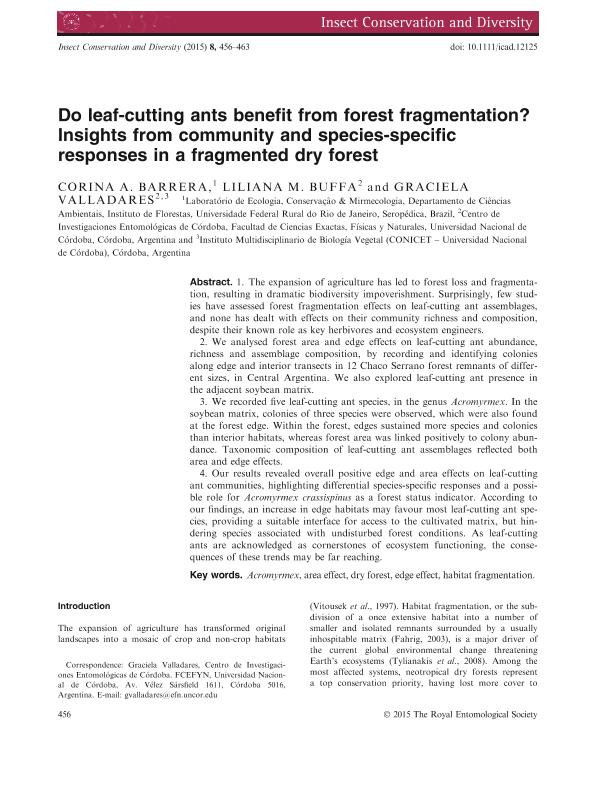Mostrar el registro sencillo del ítem
dc.contributor.author
Barrera, Corina A.

dc.contributor.author
Buffa, Liliana M.

dc.contributor.author
Valladares, Graciela Rosa

dc.date.available
2017-05-12T15:35:24Z
dc.date.issued
2015-03
dc.identifier.citation
Barrera, Corina A.; Buffa, Liliana M.; Valladares, Graciela Rosa; Do leaf-cutting ants benefit from forest fragmentation? Insights from community and species-specific responses in a fragmented dry forest; Wiley-liss, Div John Wiley & Sons Inc; Insect Conservation And Diversity; 8; 3-2015; 456-463
dc.identifier.issn
1752-458X
dc.identifier.uri
http://hdl.handle.net/11336/16372
dc.description.abstract
1.The expansion of agriculture has led to forest loss and fragmentation, resulting in dramatic biodiversity impoverishment. Surprisingly few studies have assessed forest fragmentation effects on leaf-cutting ant assemblages, and none has dealt with effects on their community richness and composition, despite their known role as key herbivores and ecosystem engineers. 2.We analyzed forest area and edge effects on leaf-cutting ant abundance, richness and assemblage composition, by recording and identifying colonies along edge and interior transects in twelve Chaco Serrano forest remnants of different sizes, in Central Argentina. We also explored leaf-cutting ant presence in the adjacent soybean matrix. 3.We recorded five leaf-cutting ant species, in the genus Acromyrmex. In the soybean matrix, colonies of three species were observed, which were also found at the forest edge. Within the forest, edges sustained more species and colonies than interior habitats, whereas forest area was linked positively to colony abundance. Taxonomic composition of leaf-cutting ant assemblages reflected both area and edge effects.4.Our results revealed overall positive edge and area effects on leaf-cutting ant communities, highlighting differential species-specific responses and a possible role for A. crassispinus as a forest status indicator. According to our findings, an increase in edge habitats may favor most leaf-cutting ant species, providing a suitable interface for access to the cultivated matrix, but hindering species associated with undisturbed forest conditions. Since leaf-cutting ants are acknowledged as cornerstones of ecosystem functioning, the consequences of these trends may be far reaching.
dc.format
application/pdf
dc.language.iso
eng
dc.publisher
Wiley-liss, Div John Wiley & Sons Inc

dc.rights
info:eu-repo/semantics/openAccess
dc.rights.uri
https://creativecommons.org/licenses/by-nc-sa/2.5/ar/
dc.subject
Acromymex
dc.subject
Dry Forest
dc.subject
Edge Effect
dc.subject
Habitat Fragmentation
dc.subject.classification
Zoología, Ornitología, Entomología, Etología

dc.subject.classification
Ciencias Biológicas

dc.subject.classification
CIENCIAS NATURALES Y EXACTAS

dc.title
Do leaf-cutting ants benefit from forest fragmentation? Insights from community and species-specific responses in a fragmented dry forest
dc.type
info:eu-repo/semantics/article
dc.type
info:ar-repo/semantics/artículo
dc.type
info:eu-repo/semantics/publishedVersion
dc.date.updated
2017-05-08T15:34:09Z
dc.journal.volume
8
dc.journal.pagination
456-463
dc.journal.pais
Estados Unidos

dc.journal.ciudad
New York
dc.description.fil
Fil: Barrera, Corina A.. Universidade Federal do Rio de Janeiro; Brasil
dc.description.fil
Fil: Buffa, Liliana M.. Universidad Nacional de Córdoba. Facultad de Ciencias Exactas, Físicas y Naturales. Centro de Investigaciones Entomológicas de Córdoba; Argentina
dc.description.fil
Fil: Valladares, Graciela Rosa. Consejo Nacional de Investigaciones Científicas y Técnicas. Centro Científico Tecnológico Conicet - Córdoba. Instituto Multidisciplinario de Biología Vegetal. Universidad Nacional de Córdoba. Facultad de Ciencias Exactas Físicas y Naturales. Instituto Multidisciplinario de Biología Vegetal; Argentina. Universidad Nacional de Córdoba. Facultad de Ciencias Exactas, Físicas y Naturales. Centro de Investigaciones Entomológicas de Córdoba; Argentina
dc.journal.title
Insect Conservation And Diversity

dc.relation.alternativeid
info:eu-repo/semantics/altIdentifier/url/http://onlinelibrary.wiley.com/doi/10.1111/icad.12125/abstract
dc.relation.alternativeid
info:eu-repo/semantics/altIdentifier/doi/http://dx.doi.org/10.1111/icad.12125
Archivos asociados
